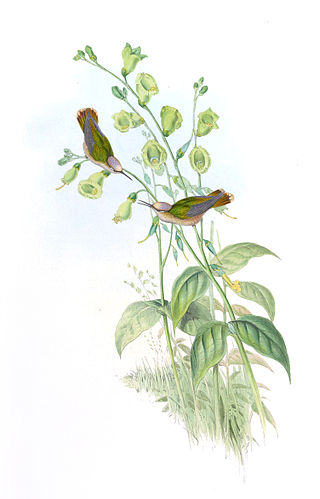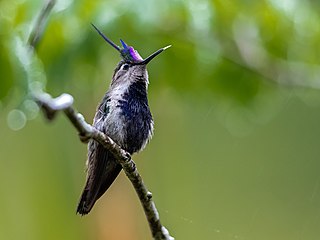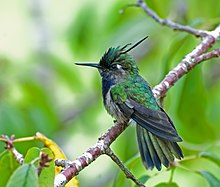
The falcons and caracaras are around 65 species of diurnal birds of prey that make up the family Falconidae. The family is divided into three subfamilies: Herpetotherinae, which includes the laughing falcon and forest falcons; Polyborinae, which includes the spot-winged falconet and the caracaras; and Falconinae, the falcons and kestrels (Falco) and falconets (Microhierax).
Virus classification is the process of naming viruses and placing them into a taxonomic system similar to the classification systems used for cellular organisms.

The laughing gull is a medium-sized gull of North and South America. Named for its laugh-like call, it is an opportunistic omnivore and scavenger. It breeds in large colonies mostly along the Atlantic coast of North America, the Caribbean, and northern South America. The two subspecies are L. a. megalopterus — which can be seen from southeast Canada down to Central America — and L. a. atricilla, which appears from the West Indies to the Venezuelan islands. The laughing gull was long placed in the genus Larus until its present placement in Leucophaeus, which follows the American Ornithologists' Union.

Caracaras are birds of prey in the family Falconidae. They are traditionally placed in subfamily Polyborinae with the forest falcons, but are sometimes considered to constitute their own subfamily, Caracarinae, or classified as members of the true falcon subfamily, Falconinae. Caracaras are principally birds of South and Central America, just reaching the southern United States.

Incertae sedis or problematica is a term used for a taxonomic group where its broader relationships are unknown or undefined. Alternatively, such groups are frequently referred to as "enigmatic taxa". In the system of open nomenclature, uncertainty at specific taxonomic levels is indicated by incertae familiae, incerti subordinis, incerti ordinis and similar terms.

The conservation status of a group of organisms indicates whether the group still exists and how likely the group is to become extinct in the near future. Many factors are taken into account when assessing conservation status: not simply the number of individuals remaining, but the overall increase or decrease in the population over time, breeding success rates, and known threats. Various systems of conservation status are in use at international, multi-country, national and local levels, as well as for consumer use such as sustainable seafood advisory lists and certification. The two international systems are by the International Union for Conservation of Nature (IUCN) and The Convention on International Trade in Endangered Species of Wild Fauna and Flora (CITES).

Eugène Louis Simon was a French naturalist who worked particularly on insects and spiders, but also on birds and plants. He is by far the most prolific spider taxonomist in history, describing over 4,000 species.

The shy albatross, also known as shy mollymawk, is a medium-sized albatross that breeds on three remote islands off the coast of Tasmania, Australia, in the southern Indian Ocean. Its lifespan is about 60 years, and it has been seen as far afield as South Africa and the Pacific coast of the United States. As of June 2020, the species is listed as "Endangered" in Australia; there are thought to be 15,000 pairs of shy albatross left. It is Australia's only endemic albatross.

The long-billed hermit is a bird in the family Trochilidae, the hummingbirds. It is found from central Mexico south through Central America, Colombia and Ecuador into Peru.

The genus Cathartes includes medium-sized to large carrion-feeding birds in the New World vulture (Cathartidae) family. The three extant species currently classified in this genus occur widely in the Americas. There is one extinct species known from the Quaternary of Cuba.

The amethyst woodstar is a species of hummingbird in tribe Mellisugini of subfamily Trochilinae, the "bee hummingbirds". It is found in every mainland South American country except Chile and Uruguay and has been recorded as a vagrant on Trinidad.

The rainbow-bearded thornbill is a species of hummingbird in the "coquettes", tribe Lesbiini of subfamily Lesbiinae. It is found in Colombia, Ecuador, and Peru.

The green-crowned plovercrest, also black-breasted plovercrest or simply plovercrest, is a species of hummingbird in the "emeralds", tribe Trochilini of subfamily Trochilinae. It is endemic to Brazil.

The Colombian crake is a species of bird in the subfamily Rallinae of the rail, crake, and coot family Rallidae. It is found in Colombia, Ecuador, and Panama.

The paint-billed crake is a species of bird in the subfamily Rallinae of the rail, crake, and coot family Rallidae. It is found in Costa Rica, Panama, every mainland South American country except Chile and Uruguay, and the Galápagos Islands.

The Cabanis's seedeater is a species of bird in the cardinal family Cardinalidae that the International Ornithological Committee (IOC) accepted as a species in 2015. It is found southern Mexico and Central America.

The Amazonian trogon, is a species of bird in the family Trogonidae, the trogons and quetzals. It is found in Bolivia, Brazil, Colombia, Ecuador, Peru, and Venezuela.

The two blossomcrowns comprise the genus Anthocephala. They were formerly considered conspecific. The SACC accepted both as distinct species in 2015.

The dusky-capped woodcreeper is a species of bird in the subfamily Dendrocolaptinae of the ovenbird family Furnariidae. It is found in Bolivia and Brazil.

The purple-crowned plovercrest, or violet-crowned plovercrest, is a species of hummingbird in the "emeralds", tribe Trochilini of subfamily Trochilinae. It is found in Argentina, Brazil, and Paraguay.





















